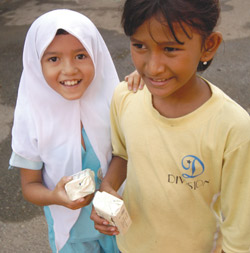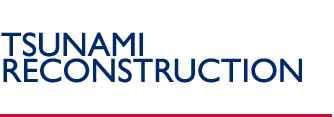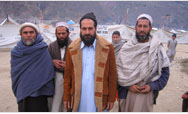 |
|
 |
 |
|
 |
 |
|
 |
 |
|
[an error occurred while processing this directive]
USAID Rebuilds Lives After the Tsunami
Fast Response Aids Tsunami Victims
 |
|
U.S. assistance is delivered by a U.S. Navy helicopter
to survivors of the tsunami in Sumatra, Indonesia.
U.S. Navy |
Despite warnings that thousands might die from disease and
lack of clean water after the Dec. 26 tsunami killed over
200,000 in Asia, prompt international relief has prevented
epidemics, and relief efforts are shifting from emergency
to rebuilding.
In the hardest-hit region—Indonesia’s Aceh province—people
are moving out of relief camps and moving in with their extended
families or other community members, according to CNN reports
and U.S. aid officials.
“The emergency is over and people are moving out of
camps. Kids are going back to school,” reported CNN Jan.
24 from Aceh.
“The emergency phase has been stabilized, and we are
moving towards rebuilding,” said Ken Isaacs, head of
the Office of U.S. Foreign Disaster Assistance (OFDA), Jan
24.
Isaacs had been in Asia directing U.S. relief efforts in
Indonesia, Sri Lanka, Thailand, India, and the Maldives.
From Utapao military base in Thailand and elsewhere in the
region, he managed the flow of charter and commercial aircraft
carrying tons of water containers, plastic shelter sheeting,
food, and other emergency supplies from USAID stockpiles in
Dubai, the Philippines, Italy, and the United States.
“When I came back two weeks ago, I felt Sri Lanka was
stabilized and Indonesia was approaching stability—in
another five to seven days, it would be past the peak of the
crisis,” Isaacs said.
The movement of people from displaced persons camps in Indonesia
and Sri Lanka is a sign they are finding ways to move in with
relatives and neighbors.
In recent years, USAID and the wider foreign aid community
have accepted that the best way to move people toward independent
lives after a disaster is to help them rebuild. So a lot of
U.S. aid is to provide people with livelihoods, said Isaacs,
such as jobs cleaning up debris and fixing roads in exchange
for pay.
About 150 USAID staff from missions in affected countries
are at work on tsunami relief. Another 50 members of the Disaster
Assistance Response Team (DART) continue to assess needs and
supply quick funding to relief projects.
As time goes on, more of the U.S. aid effort will shift
from OFDA to the Bureau for Asia and the Near East, which
has the benefit of established missions in Indonesia and Sri
Lanka, the countries most in need of help. Thailand and India
have largely been able to cope with relief on their own.
Isaacs noted, in particular, the close working relations
between the U.S. military and USAID, which assigned DART members
to coordinate with the military. This allowed military planes
based at a hub in Utapao to deliver supplies to Medan, Indonesia,
and Colombo, Sri Lanka, that were later transferred—often
by military helicopters—to survivors.
About $103 million out of the $350 million pledged by President
Bush for relief has been spent on food, shelter, water and
sanitation, livelihoods recovery, cash-for-work clean-up programs,
child protection, and physical and mental healthcare assistance.
However, U.S. private contributions to relief have totaled
more than $500 million, Isaacs said.
He told of meeting survivors in a hospital in Sri Lanka
who had their children ripped from their arms by the waves.
“Most people lost family members—the wave was so
absolute,” he said.
 |
|
Girls from an internally displaced persons camp in
Banda Aceh, Indonesia, hold up packets of fortified
biscuits. Delivered by the World Food Program (WFP),
the biscuits were made in India and donated by the German
government. The U.S. government is the main donor for
WFP, paying for about 80 percent of its annual budget.
Rein Skullerud, WFP |
The Response Management Team based at USAID in Washington
to direct U.S. relief efforts said that the last shipment
of emergency supplies was sent Jan. 18—kitchen supplies
and mosquito nets.
U.S. aid is also providing food and cash for work.
The final death tolls as of Jan. 22 were: Indonesia, 115,000;
Sri Lanka, 31,000; India, 11,000; and Thailand, 5,300. Somalia,
the Maldives, and Malaysia had small losses.
The greatest challenge currently facing relief assistance
is the difficulty in overland access along the northwestern
portion of Aceh.
Thus far, two rebel movements in Sri Lanka and Aceh have
both cooperated in relief work, and there has not been interference
with aid workers. However, Indonesia has asked foreign military
teams to pull out in the coming months, and the U.S. military
has begun to plan its withdrawal.
USAID is planning to shift to road deliveries when U.S.
helicopters are no longer available, including use of 220
International Organization for Migration trucks and charter
flights to deliver relief assistance and supplies.
The Indonesian military has also been able to obtain spare
parts for its C-130 planes.
To respond to fears that children orphaned by the tsunami
could be forced into sexual slavery, USAID provided $2 million
to UNICEF for child protection and psycho-social services:
$1.5 million for Indonesia and $500,000 for Sri Lanka.
In Sri Lanka, USAID hosted a meeting of relief organizations
and Sri Lanka officials to address issues of protection and
psychological and social support.
BACKGROUND
- A magnitude 9.0 earthquake on December 26, off the west coast of Northern Sumatra, Indonesia, triggered massive tsunamis that affected several countries throughout South and Southeast Asia, as well as Somalia, Tanzania, Kenya, and the Seychelles in East Africa. Aftershocks from the December 26 earthquake continue to occur in the region.
- Based on initial findings of USG assessment teams and on the recommendation of Secretary of State Colin Powell and USAID Administrator Andrew Natsios, on December 31, President George W. Bush committed $350 million toward earthquake and tsunami relief and recovery efforts. Dollar amounts in this Fact Sheet are part of the total pledge of $350 million and refer to specific funding actions that have been committed and programmed.
- On February 9, President Bush announced that he is seeking $950 million as part of the supplemental appropriations request to support the rehabilitation and reconstruction of areas devastated by the Indian Ocean tsunami and to cover the costs of relief efforts to date. This amount includes an additional $600 million above the President’s initial commitment of $350 million.
Back to Top ^
|


